Seedling tree species: Common deciduous tree species, how much do you know about them?
Deciduous trees play an important role in landscape gardening and have a wide range of uses. They can be used as street trees, garden shade trees, foliage, flower, fruit trees, and greening trees for industrial and mining enterprises. Deciduous trees have obvious seasonal characteristics.
Therefore, on the one hand, the rich and varied shapes, structures and colors of trees can be used to make conscious arrangements of plants; on the other hand, the leaf color of deciduous tree species often changes significantly with the seasons, and these changes play a vital role in garden landscaping.
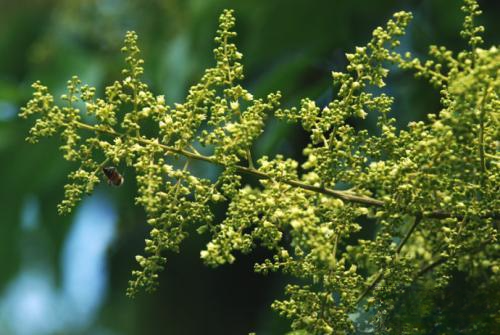
1. Koelreuteria paniculata
Other names: Luanhua, Luanhua, etc., is a plant of the Sapindaceae family and Luanhua genus. It is a deciduous tree or shrub;
The tree grows in calcium-based soil produced by weathering of limestone. It is cold-resistant and only distributed in the Yellow River Basin and the lower reaches of the Yangtze River Basin. It is rare in the north of the Haihe River Basin and cannot grow in silicon-based acidic red soil areas. The tree sprouts late in spring and sheds its leaves early in autumn, so the annual growing season is short and the growth is slow. The wood can only be used to make some small utensils, and the seeds can be used to extract industrial oil.

Growth habit:
Koelreuteria paniculata is a light-loving plant that tolerates partial shade. It is cold-resistant, but not waterlogged. Pay attention to the land when planting it. It tolerates drought and barrenness, has strong adaptability to the environment, likes to grow in calcareous soil, and tolerates salinity and short-term waterlogging. Koelreuteria paniculata has deep roots, strong sprouting ability, and medium growth rate. Young trees grow slowly, and then gradually faster. It has strong resistance to smoke and dust. It is widely planted in the Central Plains, especially in Xuchang and Yanling.
Garden value:
It has strong wind resistance and can withstand temperatures as low as -25°C. It is also highly resistant to dust, sulfur dioxide and ozone. It is mostly distributed in low mountains and plains below 1,500 meters above sea level, and can reach a maximum altitude of 2,600 meters.
The leaves of the tree are mostly red in spring, yellow flowers cover the tree in summer, and the leaves turn yellow in autumn. The fruits are purple-red and lantern-shaped, which is very beautiful. The tree has strong adaptability and obvious seasonal phases, making it an ideal greening and foliage-viewing tree. It is suitable for garden shade trees, roadside trees and landscape trees. The tree is also a good tree species for industrial pollution areas. The ornamental characteristics of the tree are that it is ornamental in spring, flowers in summer, and fruits in autumn and winter. It has been widely used as a garden shade tree, roadside tree and landscape tree, and also as a greening tree species in residential areas, factory areas and villages.
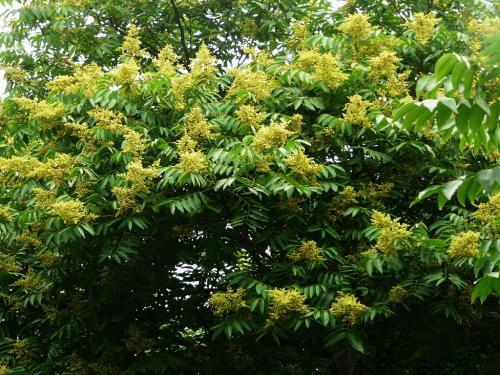
2. Liquidambar
Deciduous tree, up to 30 meters tall, with a maximum breast diameter of 1 meter. The bark is gray-brown and peels off in squares; the branches are gray, pubescent, and slightly lenticel-like.
Growth habit:
It likes warm and humid climate, light-loving, young trees are slightly shade-tolerant, drought-tolerant and barren soil-tolerant, but not waterlogged. It grows mostly in flat land, near villages, and secondary forests in low mountains. It grows well in moist, fertile and deep red-yellow loam.
It has deep roots, thick and long taproots, strong wind resistance, and is not tolerant to transplantation and pruning. The seeds have the habit of germinating every other year. It is not cold-resistant and cannot survive the winter in the open field north of the Yellow River. It is not tolerant to salinity and drought. It is a dominant species that often forms secondary forests on Hainan Island. It is fire-resistant and has a strong germination ability.
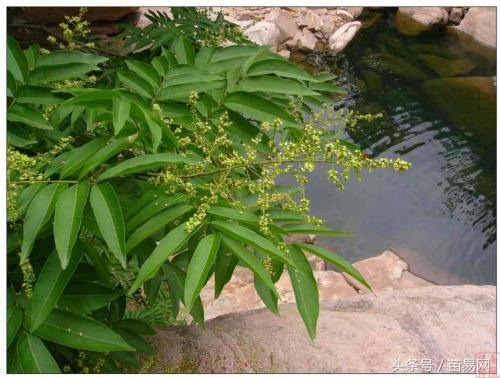
Garden value:
Liquidambar formosana can be planted as a shade tree in the garden, either alone or in a group on the grass, or mixed with other trees on the hillside or by the pond. If planted with evergreen trees, the contrast between red and green in autumn will be particularly beautiful.
Liquidambar formosana has strong fire resistance and resistance to toxic gases, so it can be used for greening factory and mining areas. However, it is not suitable for use as a street tree because it is not tolerant to pruning and large trees are difficult to transplant.
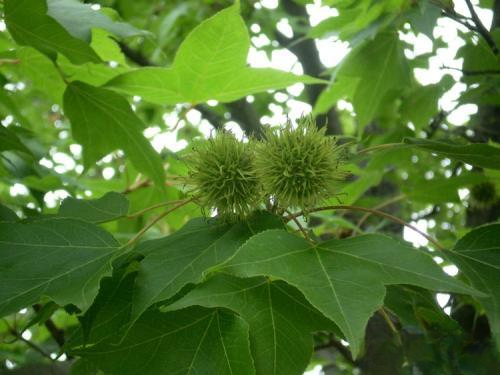
3. Soapberry
Deciduous tree, branches spread, leaves alternate; no stipules; petiole; panicle, terminal and lateral; flowers polygamous, corolla light green, with short claws; disc cup-shaped; filaments with fine hairs, attached to the back of the anther, bisexual flowers with small stamens and filaments with soft hairs. Drupe spherical, yellow or brownish yellow when ripe. Seeds spherical, black, flowering from June to July. Fruiting from September to October.
Growth habit:
It is commonly cultivated in temples, gardens and village edges in various places.
[1] It likes light, tolerates shade, and has strong cold tolerance. It is not very demanding on soil, has deep roots, and is resistant to wind. It is not resistant to waterlogging, but can tolerate drought. It has weak germination ability and is not resistant to pruning. It grows quickly and has a long lifespan.
Strong resistance to sulfur dioxide.
[2] It is the preferred tree species for ecological greening of industrial cities. It takes 5 to 6 years to grow and bears fruit once a year. It grows fast and is easy to plant and maintain. It can live 100 to 200 years.
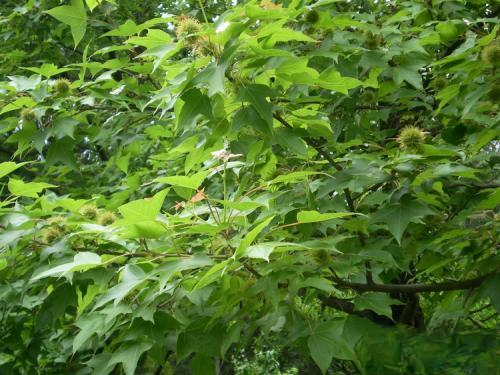
Garden value:
The trunk is straight, the branches and leaves spread out, and the shade is dense. In winter, the leaves are all golden, so it is also called the golden tree. It can be regarded as one of the colorful leaf trees. In October, the fruits are abundant, orange and yellow, and beautiful. It is an excellent foliage and fruit viewing tree for greening.
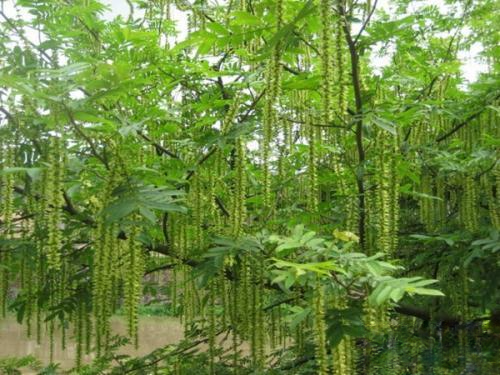
4. Maple Poplar
Other names: white poplar, big-leaf willow, big-leaf poplar, etc. Deciduous tree, up to 30 meters tall, 1 meter in diameter; young tree bark is smooth, light gray, deep longitudinal fissures when old; twigs are gray to dark brown, with grayish yellow lenticels; buds are petiolate, densely covered with rust-brown shield-shaped glands, and leaves are mostly even or odd pinnate compound leaves.
Growth habit:
Maple poplar likes light, tolerates side shade, and young trees tolerate shade, but not cold-resistant. It is mainly distributed in the south of the Yellow River Basin. Maple poplar has a broad crown, dense branches and leaves, and grows rapidly. It is a common garden shade tree and protective tree species. In addition, the bark has the effects of dispelling wind and relieving pain, killing insects, and healing sores.
It likes deep, fertile and moist soil, and is more suitable for warm temperate and subtropical climates with relatively high temperatures and abundant rainfall. It is a light-loving tree species and cannot tolerate shade. It is highly tolerant of moisture, but cannot tolerate long-term waterlogging or high water levels. It is a deep-rooted tree species with obvious taproots and well-developed lateral roots. It has strong germination ability and grows very fast.
It has weak resistance to harmful gases such as sulfur dioxide and chlorine. After being damaged, the leaves quickly change from green to reddish brown to purple brown and fall off easily. In severe cases of sulfur dioxide damage, all leaves fall off within a few hours. The growth rate of maple poplar is slow in the early stage, and accelerates in the later stage.
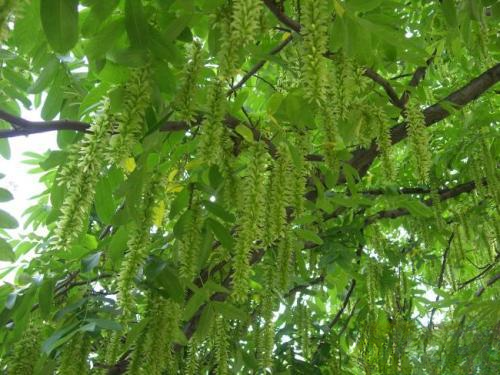
Garden value:
Maple poplar has a wide crown, dense branches and leaves, fast growth, and a well-developed root system. It is a good greening tree species for low-lying wetlands on both sides of the riverbed and can also prevent soil erosion. Maple poplar can be used as a street tree, or it can be planted in groups or alone on lawns and slopes to form a certain landscape.
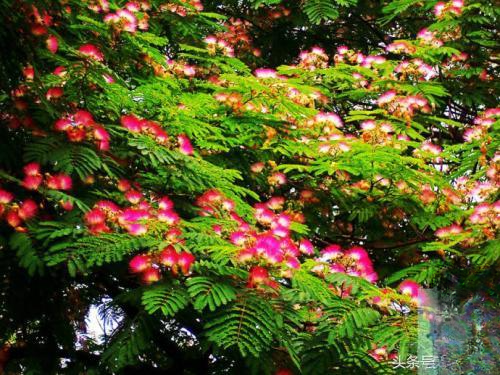
5. Albizia Julibrissin
Also known as velvet flower tree, horsetail flower. Deciduous tree, blooms in summer, with capitula, gamopetalous corolla, multiple stamens, light red
It likes light and can tolerate dryness and barrenness. The wood is reddish brown, with straight texture and fine structure. It is easy to crack when dry. It can be used to make furniture, sleepers, etc. The bark can be used to extract tannin. It is native to Japan, South Korea, and North Korea.
Growth habit:
Hehuan likes warm, humid and sunny environment, has strong adaptability to climate and soil, and is suitable for growing in well-drained and fertile soil. It is also tolerant to poor soil and drought, but not to waterlogging. It grows quickly.
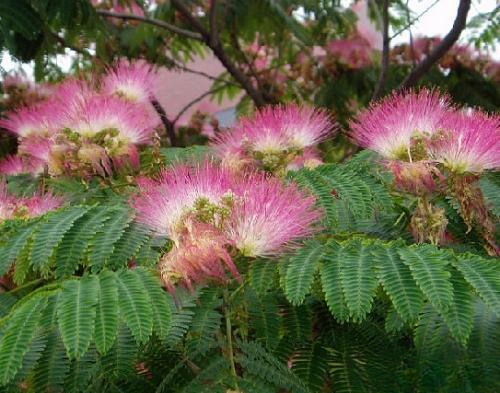
Garden value:
It likes light and warmth, is cold-resistant, drought-resistant, resistant to poor soil and mild salinity, and has strong resistance to harmful gases such as sulfur dioxide and hydrogen chloride.
Albizia julibrissin can be used as a landscape tree, street tree, scenic area landscaping tree, waterfront greening tree, factory greening tree and ecological protection tree, etc.
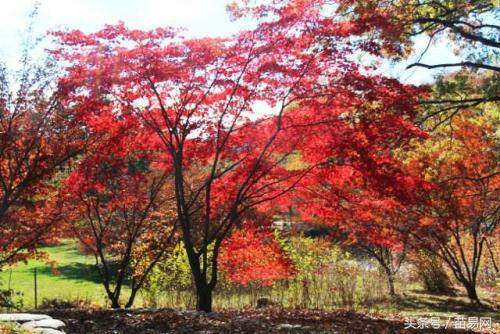
6. Acer palmatum
Also known as: Chicken Claw Maple, a small deciduous tree with umbrella-shaped crown. The bark is smooth. The bark is dark gray. The twigs are purple or light purple-green, and the old branches are light gray-purple.
The Japanese maple likes sunlight and avoids exposure to the west, which will burn the leaves. It is shade-tolerant and grows well under the shade of tall trees. It is highly resistant to sulfur dioxide and smoke. Its leaves are beautiful and turn bright red in autumn, as bright as flowers and as brilliant as clouds. It is an excellent foliage tree.
Growth habit:
It grows in the forest edge or sparse forest at an altitude of 200 to 1200 meters. [It likes sparse shade, but is afraid of sunlight exposure in summer. It has strong cold resistance and can tolerate relatively dry climate conditions. It grows mostly in moist valleys on shady slopes. It is acid and alkali resistant, relatively dry, and not resistant to waterlogging. It grows poorly in places exposed to the west sun and humid winds. It is adapted to moist and humus-rich soil.
The Japanese maple is a weak sun-loving tree species, tolerant of partial shade. If planted alone in direct sunlight, it is easily damaged by sunburn in summer. It likes warm and humid climate and fertile, moist and well-drained soil. It is cold-resistant and can adapt to acidic, neutral and calcareous soils. The growth rate is medium to slow.
It likes warm climate and grows in cool, loose and fertile land.
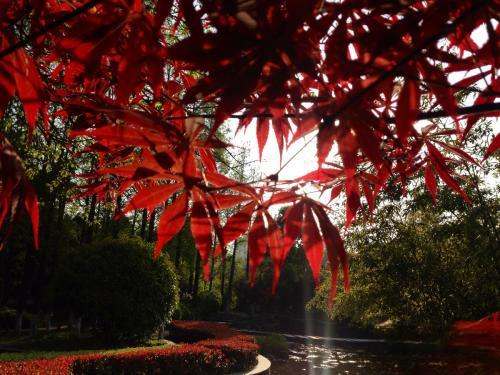
Garden value:
The Japanese maple can be planted as a roadside or ornamental tree, and is a good "four-season" greening tree species. The Japanese maple is a valuable ornamental native tree species in the garden. In garden greening, different varieties are often arranged together to form a colorful maple garden; maple varieties can also be mixed in evergreen trees to create a "red dot in the green" landscape;
Planting it at the foot of a mountain or by a pond will show its elegant and graceful demeanor; when paired with rocks, it will have an ancient and elegant appeal. In addition, it can also be planted in a flower bed as a main landscape tree, planted on both sides of a garden gate, or in the corners of a building to decorate the scenery; using it as a potted plant for indoor beautification is also very elegant.
The most striking ornamental feature of the chicken claw is that the leaf color is rich in seasonal changes. Like theoretical color, the color of the leaves also has warm and cold colors: warm colors make people feel close in color distance, while cold colors make people feel backward and far away.
In terms of psychological feeling, warm colors make people nervous and excited, and can create a relaxed and pleasant spatial atmosphere; while cold colors make people peaceful and can create a peaceful and remote spatial atmosphere.